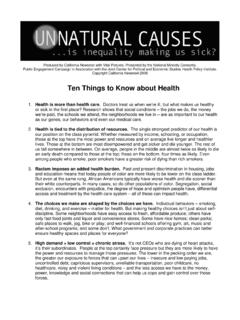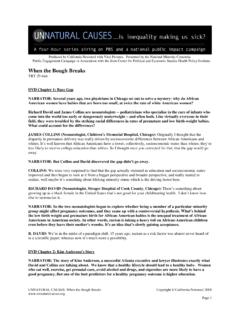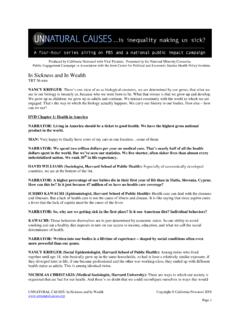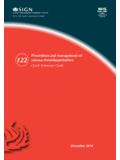Transcription of HEALTH EQUITY QUIZ - Answers - UNNATURAL …
1 California Newsreel 2008 Page 1 HEALTH EQUITY quiz - Answers 1. How does life expectancy compare to other countries? E. 29th place. At years, we are tied with South Korea and Denmark for 29th 31st place, despite being the second wealthiest country on the planet as measured by per capita GDP. Japan has the highest life expectancy at Based on the general correlation between GDP per capita and HEALTH , our average life expectancy should be 3 years longer. b Even citizens of countries considerably poorer than ours, including Costa Rica, Chile and Greece, live longer on average than we do. 2. Where did the rank in life expectancy 50 years ago? B. In the top 5. At years, life expectancy in the 1950s was longer than in most other countries.
2 Interestingly, we had less economic disparity back then compared with other countries, even Sweden. But especially starting in the 1980s, the gap in the between the rich and the rest of us began to grow as other industrialized countries began to prosper and rapidly passed us on many HEALTH indicators. Just a coincidence? 3. How much does the spend per person on HEALTH care compared to the average of the other industrialized countries? D. Two and a half times as much. We spent $6,102 per person on medical care in 2004 of our GDP. That s more than double the $2,552 median of the 30 OECD countries. So why are our HEALTH outcomes among the worst in the industrialized world, even as our medical costs continue to escalate? For one thing, our HEALTH care system can only repair our bodies.
3 The sicker people are to begin with, the greater the strains placed on our HEALTH care system. 4. How do smoking rates compare to those of other wealthy countries? E. Below 25. According to UNDP figures, Japan has the world s longest life expectancy AND the highest smoking rate among industrialized countries. The French also smoke more than we do but live longer. The Germans drink more and live longer. But the has the greatest income gap between the rich and the rest of us and the worst HEALTH . 5. What is the greatest difference in life expectancy observed between counties? C. 15 years. Our zip code is a strong indicator of our HEALTH . A recent study of Eight Americas (comparing different groups within the country) found a year gap in life expectancies at birth between the longest and shortest-lived These differences become even starker between subgroups , Asian American women in Bergen County, New Jersey, live 33 years longer than Native American men in South Dakota.
4 HEALTH expert Sir Michael Marmot noted that on a subway ride from southeast Washington, (an impoverished African American neighborhood) to Montgomery County, Maryland (an affluent white suburb), life expectancy of the surrounding communities rises about a year and a half for every mile traveled, amounting to a 20-year 6. Between 1980 and 2000, how did the life expectancy gap between the least deprived and most deprived counties in the change? E. Widened by 60%. As economic inequality grew after 1980, so did the life expectancy gap between the rich and the rest of us. In contrast, a recent study shows that premature death and infant mortality gaps narrowed between 1966 and 1980. 7. On average, how many more supermarkets are there in predominantly white neighborhoods compared to predominantly Black and Latino neighborhoods?
5 D. 4 times as many. Predominantly Black and Latino neighborhoods have more fast-food franchises and liquor stores, yet often lack stores that offer fresh, affordable fruits and vegetables. Also, residents are more likely to California Newsreel 2008 Page 2 rely on public transportation, compounding problems of access. A 2005 Chicago study found that people living in such food deserts died early in greater numbers and had more diabetes, obesity and high blood pressure. 8. The predominantly white neighborhoods in west Los Angeles contain approximately acres of park space per 1,000 residents. How many acres of park space exist per 1,000 residents in the predominantly Black and Latino neighborhoods of south central Los Angeles? E. acres.
6 That s almost 19 times more green space in white neighborhoods than Black and Latino neighborhoods! More parks means cleaner air, room to exercise and play, a place for community members to gather, not to mention higher property values and increased desirability. 9. How much does chronic illness cost the each year in lost work productivity? E. $ trillion. According to a 2007 study by the Milken Institute, the financial burden of chronic illnesses such as heart disease and diabetes goes far beyond actual medical expenses ($277 billion in 2003). Our poor HEALTH takes an even greater toll on economic productivity in the form of extra sick days, reduced performance by ailing workers, and other losses not directly related to medical care. 10.
7 African American men in Harlem have a shorter life expectancy from age five than which of the following groups? E. All of the above. Even males in Bangladesh, one of the poorest countries in the world, have a better chance of reaching age 65 than African American males in Harlem. The biggest killers in poor African American communities are not drugs or bullets but chronic diseases like stroke, diabetes and heart disease. Former Surgeon General Dr. David Satcher and colleagues calculated that 83,000 African American excess deaths could have been prevented in 2002 if Black-white differences in mortality were eliminated. 11. On average, which of the following is the best predictor of one s HEALTH ? C. Whether or not you are wealthy. The single strongest predictor of HEALTH is our position on the class pyramid.
8 Those at the top have the most power and resources, and on average live longer and healthier lives. Those on the bottom are exposed to many HEALTH threats over which they have little or no control insecure and low-paying jobs, mounting debt, poor child care, poor quality housing, less access to healthy food, unreliable transportation, and noisy and violent living conditions that increase their risk of chronic disease and early death. Even among smokers, poor smokers face a higher mortality risk than rich smokers. Those of us in the middle are still worse off than those at the top. 12. Children living in poverty are how many times more likely to have poor HEALTH , compared with children living in high-income households? D. 7 times. There s a continuous HEALTH -wealth gradient: on average, the wealthier you are, the better your HEALTH , from the top all the way to the bottom.
9 But childhood poverty has an even greater impact because children are the most vulnerable. For example, substandard housing conditions can trigger asthma and other respiratory problems; lack of access to fresh, nutritious food stunts growth, affects learning and contributes to obesity; an unsafe neighborhood breeds violence, raises stress hormones and limits opportunities for exercise; and poor schools limit job prospects and future socioeconomic success. The effects of childhood poverty are cumulative, lasting into adulthood and even the next generation. 13. Generally speaking, which group has the best overall HEALTH in the A. Recent Latino immigrants. Several studies suggest that recent Latino immigrants have better HEALTH outcomes than other populations despite being, on average, poorer.
10 However, the longer they live here, the worse they fare. This phenomenon is sometimes called the Latino paradox. Five years after arrival, Latino immigrants HEALTH begins to erode; within a generation, Latinos lose their advantage and experience the higher-than-average disease rates comparable to other low-income populations. 14. Chronic stress increases the risk of all of the following except: C. Sickle cell anemia. Sickle cell anemia is a genetically inherited disease. Chronic stress is a risk factor for all the other conditions. Like gunning a car, the stress response, even if low level, can wear down our systems over time and increase our susceptibility to disease. The lower we are in the class and racial hierarchy, the greater our exposures to stressors that threaten our HEALTH , and the less access we have to resources that help us cope.









